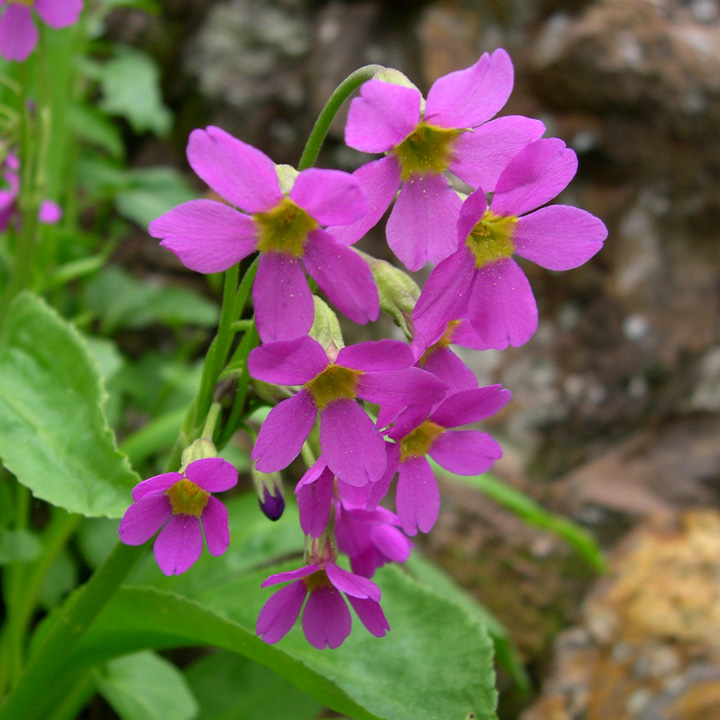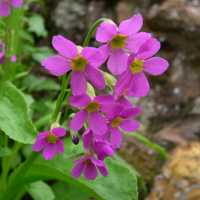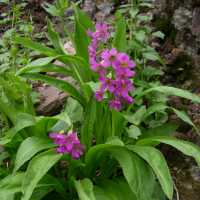Plants 15-50 cm, herbaceous; rhizomes short, stout; rosettes often clumped; vegetative parts efarinose. Leaves rankly aromatic, indistinctly petiolate; petiole broadly winged; blade without deep reticulate veins abaxially, broadly lanceolate or oblanceolate to oblong-obovate, 1-33(-40) × 1.5-7 cm, thick, margins almost entire or remotely denticulate, apex rounded to acute, surfaces glabrous. Inflorescences 5-25-flowered; involucral bracts plane, unequal. Pedicels arcuate, somewhat thick, 10-50 mm, length 1-6 times bracts, flexuous. Flowers heterostylous; calyx green, often purple tinged, cylindric to campanulate, 8-15 mm; corolla magenta, tube 5-20 mm, length 0.9-1 times calyx, with prominent glands basally and distally, limb 10-25 mm diam., lobes 5-12 mm, apex emarginate. Capsules ellipsoid to cylindric, length 1 times calyx. Seeds without flanged edges, reticulate. 2n = 44.
Flowering summer. Subalpine bogs, streamsides, wet meadows; 2700-4200 m; Ariz., Colo., Idaho, Mont., Nev., N.Mex., Utah, Wyo.
Primula parryi has the largest and most showy plants of the native North American primroses, growing to almost 50 centimeters in protected sites. It is common on subalpine streamsides and also occurs on the alpine tundra in wet areas near snowmelt seeps. The strong skunky odor of this species is unique in the North American primroses, often lingering even on herbarium specimens. It is the most common species of the genus in the western United States.
Plant: perennial herb; 10-40 cm tall, upright stems
Leaves: 10-55 cm long; blade tapering to the base, elliptic to obovate, the margins entire in ours
INFLORESCENCE: a scapose umbel, bracts 5-18 mm long
Flowers: reddish-purple with yellow center, drying blue; calyx 7-30 mm long, glandular-pubescent, the glands brownish-yellow; corolla tube 7-15 mm long, the lobes 4-10 mm long; stamens 5, generally attached to the upper portion of the corolla tube; style generally shorter than the corolla tube; ovary superior
Fruit: FRUITS valvate
Misc: Springs and streamsides, damp ledges, cliff faces, crevices, and talus; 3050-3850 m (10000-12700 ft); Jun-Aug
REFERENCES: Cholewa Anita F. 1992. Primulaceae. Ariz.-Nev. Acad. Sci. 26(1)2.
General: Perennial, 10-40 cm tall; scape stout, erect; herbage glandular-puberulent, sometimes glabrous towards the base; roots fleshy.
Leaves: Basal, erect, sometimes surpassing the scape, elliptic, obovate, or oblanceolate, 10-55 cm long, 1.5-5 cm wide, margins entire, base gradually tapering to the petiole, apex obtuse to acute; petiole winged.
Flowers: Inflorescence of solitary, axillary flowers; pedicels arched-ascending, 3-6 cm long; calyx 4-9 mm long, lobes 5, lanceolate to narrowly elliptic; corolla disc-shaped, the tube short, glandular-puberulent within, lobes 5, obovate, 7-13 mm long, yellow, apex often mucronate; stamens 5; flowers July-September.
Fruits: Capsule, ovoid, 7-9 mm long, 5-valved; seeds numerous.
Ecology: Alpine and subalpine meadows, springs, streambanks, ledges, rocky outcrops, mixed conifer forests; 2900-3700 m (9500-12000 ft); Apache and Coconino counties; western and southwestern U.S.
Notes: Some find this plant to be malodorous, especially when it occurs in large patches. It makes a lovely addition to the alpine garden, if it can be provided with ample amounts of moisture.
Editor: Springer et al. 2008





